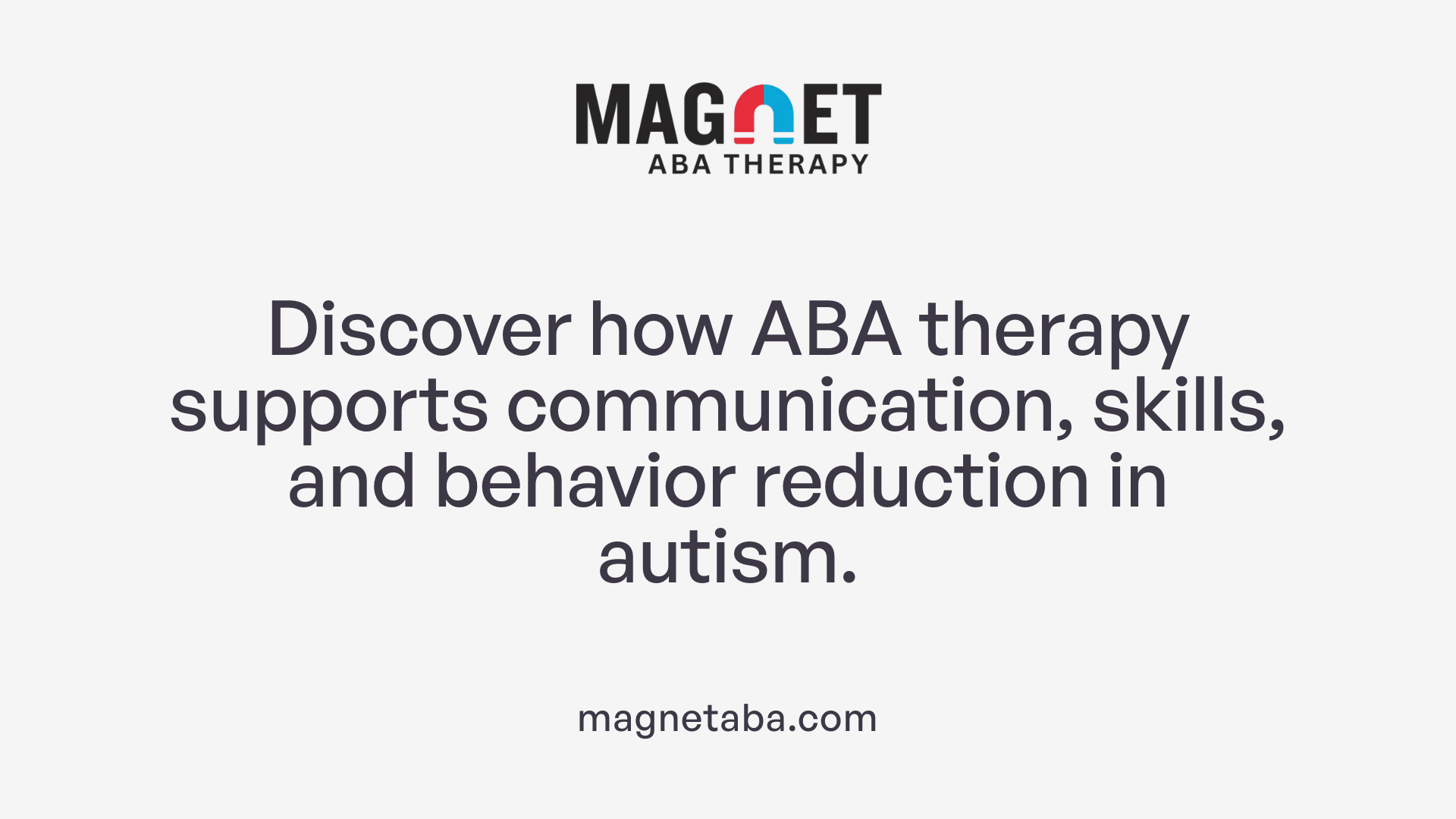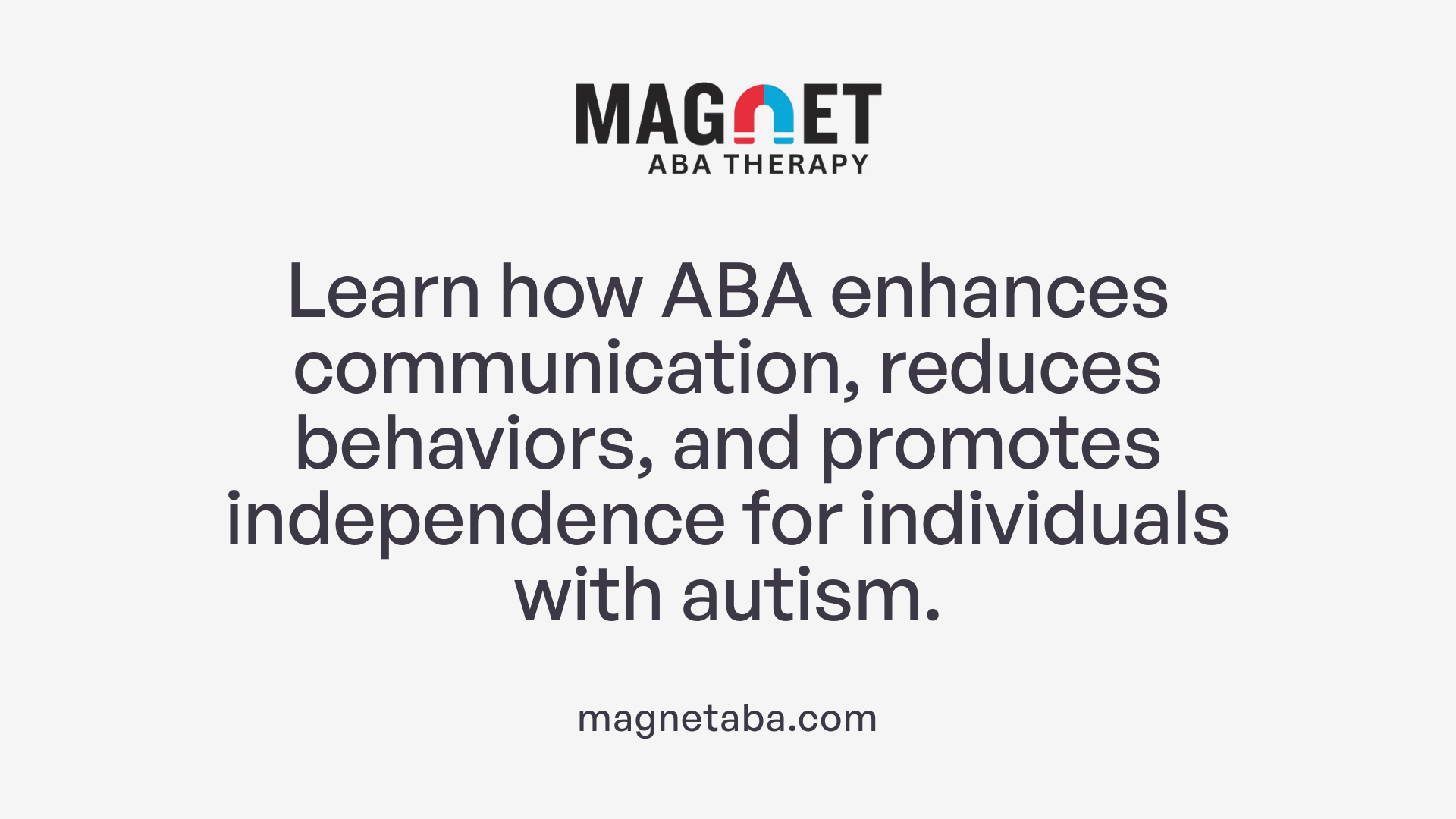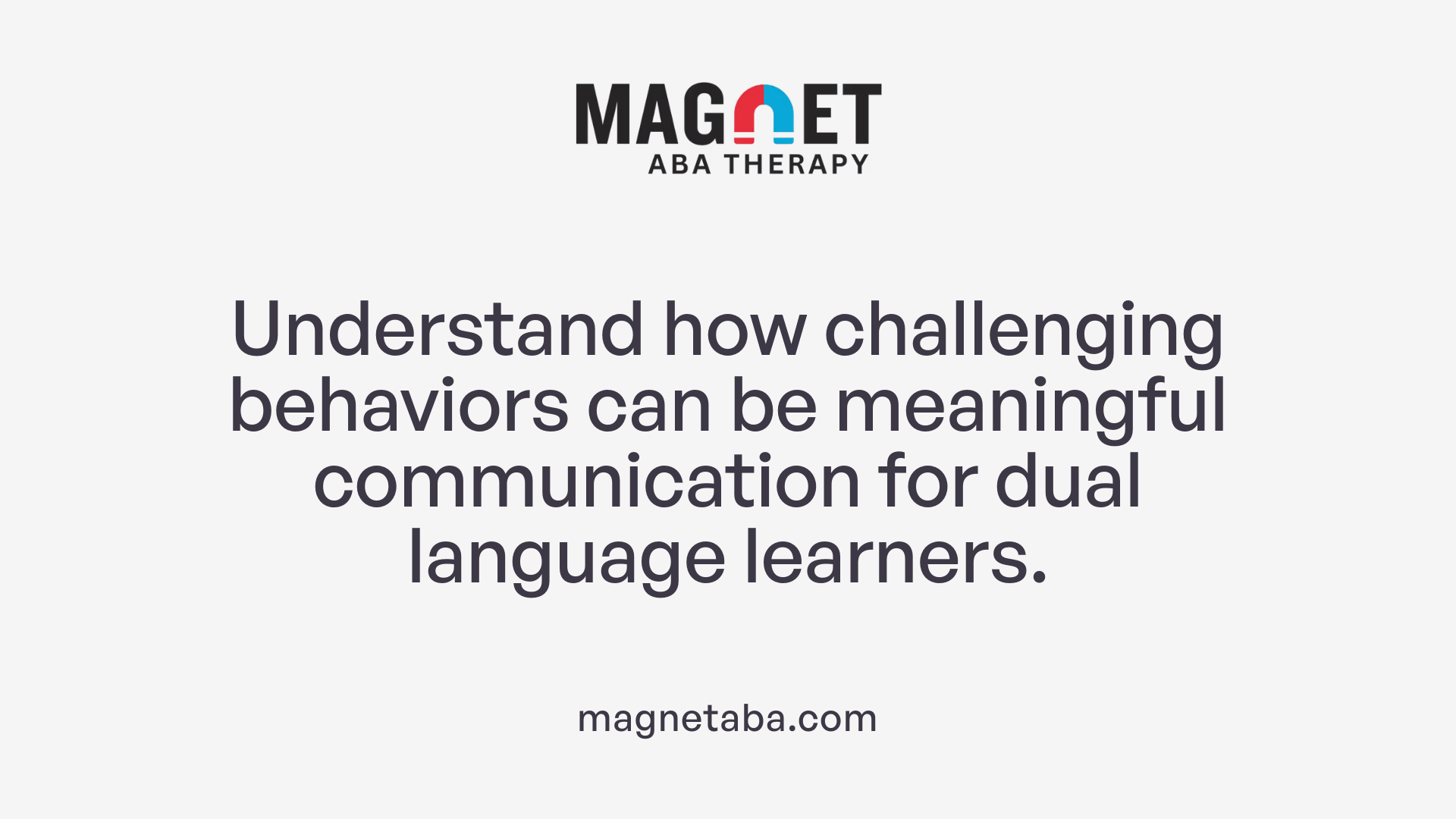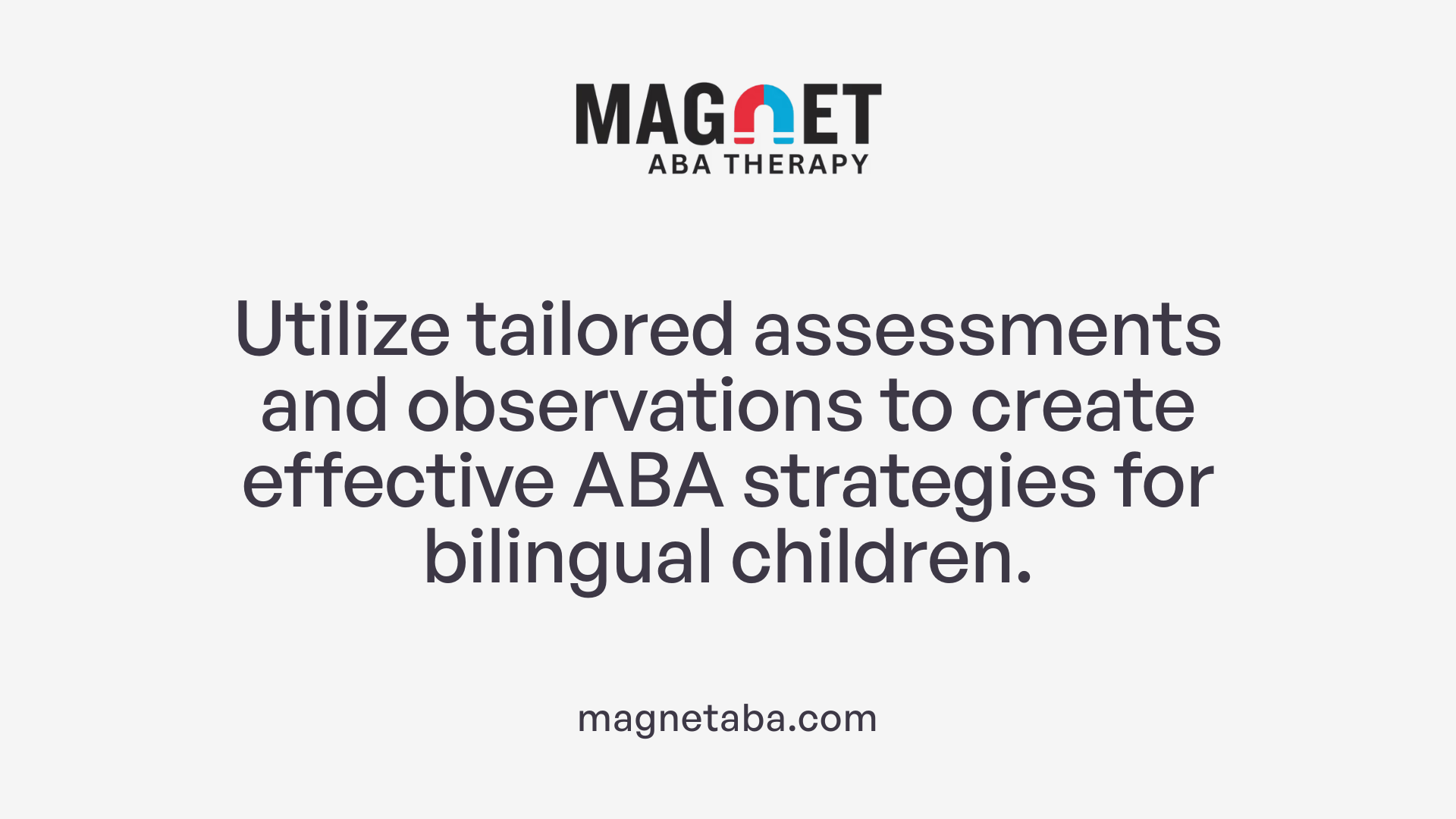Bridging Language and Behavioral Support in Autism Therapy
Applied Behavior Analysis (ABA) therapy is a cornerstone treatment for individuals with autism spectrum disorder (ASD), focusing on enhancing communication, social, and daily living skills while reducing challenging behaviors. As the population of children learning multiple languages grows, it becomes increasingly important to adapt ABA practices to effectively support dual-language learners (DLLs). This narrative explores how bilingualism intersects with behavioral therapies, highlighting strategies for supporting DLLs, the role of families, and professional practices that honor linguistic and cultural diversity within ABA frameworks.
Understanding Behavioral Analysis Therapy for Autism

What is therapy based on behavioral analysis for autism?
Therapy based on behavioral analysis for autism, primarily Applied Behavior Analysis (ABA), is a scientifically supported method focused on improving useful behaviors and reducing problematic ones.
ABA analyzes the relationships among behaviors, their triggers, and effects to teach essential skills for daily living and social interaction. Each treatment plan is tailored to the individual’s unique needs and often guided by Board Certified Behavior Analysts (BCBAs).
Key components of ABA
ABA therapy involves:
- Skill acquisition targeting communication, social, and adaptive abilities
- Behavior reduction to decrease challenging or harmful behaviors
- Functional Behavior Assessments (FBA) that identify reasons behind behaviors
- Parent or caregiver training to help transfer and generalize learned skills
Methods and techniques used in ABA
ABA employs diverse teaching strategies, including:
- Discrete Trial Training (DTT), which breaks skills into smaller steps
- Naturalistic approaches encouraging learning in everyday environments
- Play-based and peer interaction methods to promote socialization
These methods are delivered through intensive sessions, often requiring at least four hours daily over many months.
Evidence supporting ABA effectiveness
Over the past five decades, extensive research supports ABA as an evidence-based best practice for autism spectrum disorders. It has shown to improve communication, reduce restrictive and repetitive behaviors, and enhance community integration, especially in young children with level 2 or 3 severity.
Programs incorporate ongoing assessments and adjustments, with measurable goals and parent involvement, ensuring therapy stays responsive to the child’s progress and family needs.
Qualified Providers and Collaborative Teams in ABA Therapy

Who Provides Behavioral Analysis Therapy for Autism?
Behavioral analysis therapy for autism is primarily delivered by a multidisciplinary team trained in Applied Behavior Analysis (ABA). The core providers include Board Certified Behavior Analysts (BCBAs), Board Certified Assistant Behavior Analysts (BCaBAs), and Registered Behavior Technicians (RBTs).
Roles of BCBAs, BCaBAs, and RBTs
- BCBAs: These professionals hold advanced degrees and are responsible for conducting functional behavior assessments, developing individualized treatment plans, and supervising therapy sessions. They establish treatment goals, evaluate progress, and adjust interventions to meet each child’s unique needs.
- BCaBAs: Functioning under BCBA supervision, BCaBAs assist in creating and revising behavior plans and provide direct therapeutic support.
- RBTs: Registered Behavior Technicians deliver hands-on therapy, implementing the strategies and teaching skills as designed by BCBAs and BCaBAs. They work closely with children and families in various settings.
Settings Where ABA Is Provided
ABA therapy can take place in multiple environments including specialized clinics, schools, home settings, and community locations. This flexibility ensures that interventions occur in natural environments encouraging social engagement and skill generalization.
Importance of Coordinated Care
Effective ABA therapy relies on collaboration among behavioral professionals, families, and often bilingual or special education experts. Coordinated care enhances the relevance and cultural responsiveness of interventions, particularly beneficial for multilingual children and those with co-occurring diagnoses.
Licensing and Program Requirements
Providers delivering ABA therapy must be licensed as Intensive Behavioral Health Services (IBHS) agencies, adhere to specific enrollment criteria, and ideally operate within high-need geographic areas. Programs typically operate year-round, providing at least four hours of intensive treatment daily across a minimum of 240 program days annually.
Together, these qualified providers and structured program requirements foster comprehensive, individualized supports that maximize developmental and behavioral outcomes for children with autism.
Core Benefits of ABA Therapy for Individuals with Autism

What are the key benefits of behavioral analysis therapy for individuals with autism?
Applied Behavior Analysis (ABA) therapy is a widely recognized and evidence-based approach for supporting individuals with autism spectrum disorder (ASD). Its core benefits span several important areas that contribute to improved quality of life.
Improvements in Communication and Socialization
ABA therapy focuses on enhancing communication skills by using tailored interventions to support language development and social interaction. This is particularly valuable for children with ASD, many of whom face challenges in expressing needs and engaging socially. By promoting natural environment interactions and encouraging peer engagement, ABA helps build effective communication patterns and strengthens social connections.
Reduction of Problematic Behaviors
Behavioral challenges are often a form of communication for children with autism. ABA therapies carefully assess the function of behaviors and employ strategies like positive reinforcement to reduce behaviors that interfere with learning or social participation. This approach fosters more adaptive behaviors, easing daily functioning and improving interactions within families and communities.
Skill Acquisition and Increased Independence
ABA-EC (Early Childhood) programs help children develop essential skills needed to live and learn in age-appropriate, least-restrictive settings. These skills include self-care, academic readiness, and adaptive behaviors that pave the way for greater independence both at home and in school environments.
Family Empowerment and Involvement
A vital component of ABA therapy is the close collaboration and training provided to parents and caregivers. Regular training sessions ensure skills are generalized into daily routines, empowering families with tools to support their child's progress. This partnership encourages long-term success and fosters family confidence in managing developmental challenges.
Together, these benefits illustrate how ABA therapy delivers comprehensive support tailored to the unique needs of individuals with autism, promoting meaningful improvements across communication, behavior, skills, and family engagement.
Mechanisms of Behavior Change in ABA Therapy
How ABC model informs intervention
Applied Behavior Analysis (ABA) therapy relies heavily on the ABC model—Antecedent, Behavior, Consequence—to understand and improve behaviors in individuals with autism. The model identifies what triggers a behavior (antecedent), the behavior itself, and the outcome that follows (consequence). By analyzing these elements, therapists can pinpoint why a behavior occurs and tailor interventions to modify or replace challenging behaviors with more adaptive alternatives.
Data-driven treatment planning
Treatment plans in ABA are highly individualized and data-driven. Assessments including functional behavior analysis and skills evaluations gather information to create strength-based, goal-oriented plans. Data collected during therapy sessions help track progress and inform adjustments, ensuring interventions effectively target skill acquisition and behavior reduction.
Techniques including reinforcement and prompting
Key techniques used in ABA include positive reinforcement to encourage desired behaviors and prompting to support skill acquisition. Other strategies such as chaining (breaking down complex behaviors into smaller steps) also aid learning. These methods collectively promote communication, social skills, self-care, and academic abilities, especially in early childhood where development is critical.
Role of parent involvement and generalization
Parent and caregiver participation is integral to ABA success. Training sessions, conducted regularly, equip families with strategies to reinforce skills at home. This fosters skill generalization across settings, enhancing lasting behavior change. Collaboration between therapists and families ensures consistency and reinforces progress beyond clinical environments.
Choosing the Right ABA Provider: Family Considerations
What should families consider when choosing a behavioral analysis therapy provider?
Selecting the appropriate Applied Behavior Analysis (ABA) provider is critical for families seeking effective support for children with autism or other neurodevelopmental differences. Families should first verify that providers employ licensed Intensive Behavioral Health Services (IBHS) agencies, with staff supervised by Board Certified Behavior Analysts (BCBAs). Providers must meet specific enrollment and licensing criteria and possess experience in treating young children, especially those aged 3-5 who require intensive and structured interventions.
Evidence-based practice is essential; families should inquire about the provider’s use of data-driven individualized treatment plans (ITPs). These plans should be strength-based, goal-oriented, and frequently reviewed to track progress on skill acquisition, behavior reduction, and transition strategies. Program intensity often involves a minimum of four hours per day over at least 240 days annually, emphasizing functional, natural environment interactions and age-appropriate social engagement.
Family involvement is a cornerstone of effective ABA therapy. Many programs require parent or caregiver participation in training sessions, typically biweekly to monthly with at least one home visit quarterly. This collaboration helps generalize learned skills across settings and ensures consistent support. Providers should offer culturally and linguistically appropriate materials and incorporate families’ language preferences to promote an inclusive, respectful atmosphere.
Indicators of quality ABA providers include timely acceptance of referrals, transparent communication, and strong community integration efforts. Positive family satisfaction ratings and measurable child progress underscore program effectiveness. Conversely, families should watch for red flags such as inadequate supervision by certified professionals, use of aversive techniques, lack of individualized approaches, or poor family engagement.
Lastly, considering logistical aspects—like insurance coverage, location within the community, and responsiveness—can further help families identify a suitable and effective ABA program tailored to their child’s unique developmental needs.
Dual Language Learning and Autism: Dispelling Myths about Bilingualism
Is bilingualism linked to language delay?
There is no scientific evidence to support the idea that bilingualism causes language delay. According to the Division for Early Childhood (DEC, 2010), supporting a child's home language while helping them learn English is beneficial and recommended. Children growing up in bilingual environments do not inherently experience developmental delays simply because they are exposed to more than one language.
Why is supporting a child's home language important?
Supporting a child’s native language fosters a strong cultural identity and creates a welcoming environment, especially in early childhood settings. Providing culturally and linguistically appropriate materials — like survival words in the home language — encourages language development. It also helps reduce stress that might arise from language barriers, which can manifest as challenging behaviors.
How do language acquisition and developmental disorders interact?
For children with neurodevelopmental differences, such as autism spectrum disorder, language acquisition can be complex but bilingualism does not worsen developmental issues. Behavioral challenges in dual language learners often reflect stress related to language or environmental factors rather than language delay itself. Effective observations and assessments are crucial to distinguish between language-related stress and developmental concerns, guiding appropriate supports.
Why is valuing diverse linguistic backgrounds vital?
Recognizing and honoring children’s diverse linguistic and cultural backgrounds strengthens their confidence and supports social-emotional development. Educational strategies that include translanguaging, peer support, visual cues, and culturally responsive teaching promote inclusive learning environments. Valuing multiple languages helps children feel a sense of belonging and enhances their ability to acquire English without losing their heritage languages.
By dispelling myths around bilingualism and embracing a child’s full linguistic identity, educators and caregivers can better nurture language growth and overall development in dual language learners, including those with autism.
Behavior as Communication in Dual Language Learners

Challenging behaviors often stem from language barriers and stress
Behavior in young children, especially those learning two languages, is often their way of communicating needs and feelings. When dual language learners face language barriers or unfamiliar environments, this can cause stress, which may lead to challenging behaviors. Understanding that such behaviors are often reactions to communication difficulties or environmental stress helps caregivers and educators respond with empathy rather than discipline.
Need for careful functional behavior assessment
To support dual language learners effectively, it's essential to closely observe and assess their behaviors. Functional behavior assessments help identify the reasons behind a child's challenging actions by examining what triggers the behavior and what the child might be trying to express. This careful process ensures that interventions are tailored to each child's specific needs rather than applying a one-size-fits-all approach.
Differentiating language-related issues from developmental concerns
One of the complexities in working with dual language learners is distinguishing whether behaviors come from language-related stress or from underlying developmental issues. Since bilingualism itself does not cause language delay, educators and specialists need to consider multiple factors. Proper assessments and observations help avoid mislabeling children and ensure that supports are appropriate—whether that means providing additional language support or addressing developmental challenges through therapies like ABA.
By viewing challenging behaviors as meaningful communication and conducting thorough functional assessments, educators and specialists can better support dual language learners in both their language development and overall well-being.
Assessment and Observation to Inform Effective ABA for DLLs

Role of Observation in Diagnosing Behavior Function
Behavior serves as a fundamental form of communication, especially in dual language learners (DLLs) where challenging behaviors often arise from language barriers or environmental stress. Effective observation enables practitioners to discern whether behaviors stem from developmental issues, language-related stress, or other factors. This understanding is critical for developing targeted interventions.
Language Assessments Accounting for Bilingualism
Comprehensive language assessments tailored to bilingual children consider their home language alongside English proficiency. Utilizing culturally and linguistically appropriate materials, such as survival words in the child’s home language, ensures accurate evaluation and helps to prevent misdiagnosis of language delays.
Integrating Functional Behavior Assessments and Skill Evaluations
Functional Behavior Assessments (FBAs) combined with detailed skills assessments form a cornerstone for individualized treatment planning. By identifying the functions behind behaviors and measuring skill deficits across languages, providers can develop strength-based, goal-oriented plans that address both behavior reduction and skill acquisition.
Adapting Treatment Plans Based on Assessment Data
Assessment findings directly inform the creation and ongoing revision of Individualized Treatment Plans (ITPs). Plans include parent training, strategies for behavior reduction, and transition supports, with reviews at least every six months. Emphasis is placed on honoring the child’s linguistic preferences and cultural background to enhance treatment effectiveness and foster generalization of acquired skills in natural environments.
Strategies to Support Dual Language Learners in ABA Settings
Reducing Large Group Lessons and Sensory Overload
Large group lessons can overwhelm dual language learners, often increasing stress due to language barriers and sensory overload. Minimizing these activities allows for more individualized attention, helping children focus better and participate actively without feeling pressured or lost in the crowd.
Using Visual Cues and Graphic Organizers
Visual supports such as picture schedules, graphic organizers, and labeled materials serve as powerful communication tools. They aid comprehension by providing clear context and associations that transcend language, easing understanding and reducing frustration.
Encouraging Peer Support and Interaction
Peer interaction offers naturalistic opportunities for language practice and social engagement. Encouraging children to support one another through cooperative tasks and play fosters a relaxed environment where dual language learners can gain confidence, improve communication, and build relationships.
Maintaining Predictable Routines
Predictable daily routines create a sense of security and decrease anxiety originating from language challenges. Consistency in schedules and transitions helps children anticipate what comes next, making it easier for them to adapt and participate fully in activities.
Integrating these strategies within ABA programs not only supports language development but also addresses behavioral concerns linked to language-related stress. This approach aligns with providing culturally responsive, individualized care that promotes skill acquisition and inclusion for dual language learners.
Culturally and Linguistically Responsive Materials in ABA Therapy
Providing Survival Words and Key Phrases in Home Languages
In ABA therapy settings, offering materials that include survival words and essential phrases in the child's home language creates a welcoming and supportive environment. These resources help children feel seen and respected, easing stress related to language barriers and fostering comfort in early learning environments.
Using Bilingual and Culturally Rich Resources
Incorporating bilingual books and culturally rich materials enhances engagement and promotes language development. These resources not only support literacy but also enable children to connect academic content to their own cultural backgrounds. This connection can boost confidence and encourage sharing with family members who speak the home language.
Benefits of Translanguaging and Honoring Home Languages
Strategies such as translanguaging—which allow children to switch fluidly between languages—strengthen both the home language and English proficiency. Honoring home languages validates the child's cultural identity and aids communication development, reducing behavioral challenges linked to language stress.
Enhancing Language Growth and Cultural Identity
Culturally responsive materials contribute to language growth by integrating familiar cultural elements, supporting social skills, and nurturing a strong sense of belonging. This approach aligns with best practices in ABA, where individualized supports that respect linguistic diversity promote more meaningful and effective intervention outcomes.
Family Engagement and Collaborative Partnerships
Building strong family-provider relationships
Strong partnerships between families and providers are fundamental to supporting dual language learners, especially those receiving ABA interventions. These relationships foster trust and open communication, enabling tailored support that respects cultural and linguistic backgrounds.
Supporting families with bilingual and special education professionals
Collaboration among families, bilingual educators, and special education professionals enhances the support system for children. This joint effort ensures that interventions consider both language development and developmental needs, using culturally and linguistically responsive practices.
Parent training as core to ABA programs
Parent and caregiver involvement is integral to ABA programs. Mandatory training sessions, which occur biweekly to monthly and include at least one home visit quarterly, equip families with the skills to reinforce treatment goals. This training supports the generalization of skills from clinical settings to everyday environments, promoting consistency and more effective learning.
Incorporating family values and language preferences
Effective ABA interventions honor family values and language preferences by incorporating culturally relevant materials and respecting heritage languages. Training for Board Certified Behavior Analysts (BCBAs) emphasizes assessing family language use and tailoring support accordingly. This approach not only bolsters children’s language development but also strengthens cultural identity and social skills.
By integrating these elements, early childhood programs and ABA services create inclusive, collaborative environments that empower families and foster children’s holistic growth.
Professional Development for Supporting Multilingual Families in ABA
Current gaps in BCBA knowledge about bilingualism
Board Certified Behavior Analysts (BCBAs) often report limited knowledge and training specific to supporting bilingual children and their families in autism care. This gap underscores the challenges in delivering culturally and linguistically appropriate interventions.
Impact of targeted professional development and just-in-time training
Targeted professional development (PD) training framed around adult learning theory and just-in-time methods has proven effective in increasing BCBA knowledge and self-efficacy related to managing multilingual autism cases. Such training provides practical, immediately applicable skills that enhance provider confidence and clinical outcomes.
Use of asynchronous online training to enhance self-efficacy
Short, asynchronous online PD sessions offer a flexible, accessible format that has successfully boosted provider knowledge and perceived self-efficacy. This approach allows BCBAs to engage with content at their own pace, fitting training around their existing commitments without sacrificing quality or depth.
Focus on measuring language preferences and tailoring care
A critical component of these trainings involves learning to measure and honor families' language preferences, assess family values regarding language use, and tailor interventions accordingly. This culturally responsive approach supports better engagement and more effective, individualized care for multilingual families.
Participants have rated these training modules as socially valid, appreciating the emphasis on equity and inclusive language. Incorporating such professional development is essential to improving ABA services and outcomes for multilingual autistic children and their families.
Instructional Strategies Enhancing Language Development for DLLs
Multimodal Teaching: Combining Auditory, Kinesthetic, and Visual Elements
To foster an inclusive learning environment for dual language learners (DLLs), educators utilize a variety of instructional strategies that appeal to different senses. Incorporating auditory, kinesthetic, and visual elements enables DLLs to access information in ways that resonate with their individual learning styles. For example, auditory learning through songs and spoken instructions, kinesthetic activities involving hands-on tasks, and visual stimuli such as pictures and graphic organizers all contribute to deeper understanding and retention.
Interactive Activities: Engaging Through Games and Role-Playing
Interactive activities like games, role-playing scenarios, and music listening create engaging, practical opportunities for language use. These activities encourage active participation and make the learning process enjoyable. Role-playing, for instance, allows children to practice conversational skills in real-life contexts, supporting both language development and social interaction. Likewise, games foster cooperative learning and enhance vocabulary acquisition through fun repetition.
Encouraging Peer and Group Discussions for Language Practice
Providing regular opportunities for peer and group discussions enables DLLs to practice language skills in a relaxed, natural setting. These interactions boost confidence and fluency by allowing children to hear and use English alongside their home languages, which also supports translanguaging strategies. Such collaborative discussions encourage shared learning, build social bonds, and strengthen communication skills relevant to academic and everyday situations.
Visual Aids to Support Comprehension and Vocabulary
Visual aids play a critical role in enhancing comprehension and vocabulary development. Tools such as graphic organizers, labeled pictures, and environmental print (e.g., familiar brand packaging) help DLLs connect new concepts to their existing knowledge. Visuals also provide cross-language connections that deepen understanding and facilitate language transfer between English and the home language. These supports reduce cognitive overload and make abstract ideas more accessible.
Collectively, these instructional strategies contribute to an enriching and supportive environment for DLLs, promoting both language growth and academic success. Educators are encouraged to integrate these methods thoughtfully and monitor student progress regularly to fine-tune approaches as needed.
Preventative and Inclusive Approaches in Early Childhood ABA Programs
Thorough Language and Developmental Assessments
Conducting comprehensive language assessments alongside developmental evaluations is vital for early identification of needs in dual language learners. Functional behavior assessments help discern whether challenging behaviors stem from language-related stress or developmental concerns, thereby guiding appropriate intervention plans.
Culturally Responsive Teaching Practices
Implementing culturally responsive methods involves honoring children’s home languages through translanguaging strategies and providing linguistically appropriate materials. This approach fosters children’s cultural identity while enhancing their language growth.
Creating Inclusive and Welcoming Classroom Environments
Inclusive classrooms utilize visual aids, graphic organizers, and environmental print like familiar product packaging to support comprehension. Encouraging peer support and maintaining predictable routines help reduce anxiety linked to language barriers, making the learning environment more accessible and supportive.
Reducing Behavior Issues Related to Language Challenges
Preventative strategies focus on minimizing large group lessons and using multimodal instructional techniques incorporating auditory, kinesthetic, and visual elements. These practices engage students actively and reduce challenging behaviors by addressing frustration linked to communication difficulties.
These combined efforts promote naturalistic skill acquisition within the least restrictive settings. Engaging families through culturally sensitive collaboration and providing ongoing training for behavior analysts further strengthens the support system around dual language learners in early childhood ABA programs.
Monitoring Progress and Adjusting ABA Interventions for DLLs
Regular assessment in both home and English languages
Monitoring progress among dual language learners (DLLs) in ABA programs requires thorough assessment in both the child's home language and English. This dual-language evaluation ensures a comprehensive understanding of the child's communication skills and overall development without language barriers masking true abilities.
Use of informal and formal feedback methods
Feedback on the child's progress should come from multiple sources, including informal observations by educators and caregivers, as well as formal testing protocols. Informal feedback captures day-to-day behaviors and skill use in natural settings, while formal assessments provide structured data to measure developmental milestones and treatment efficacy.
Data-driven adjustments in treatment plans
Treatment plans (Individualized Treatment Plans or ITPs) must be regularly reviewed and adjusted based on ongoing data collected from these assessments. Using data enables practitioners to identify which strategies are effective and which need modification, ensuring that interventions remain strength-based and goal-oriented.
Tracking functional skills and behavioral improvements
Progress monitoring focuses on both skill acquisition—such as communication, socialization, and adaptive behaviors—and reduction of challenging behaviors. Tracking these areas helps inform when to adjust teaching methods, increase parent training sessions, or introduce new techniques like visual aids or peer support to support language and social skills.
These strategies collectively create a responsive and flexible ABA program that respects linguistic and cultural diversity while promoting the child's success in both home and school environments.
Embracing Linguistic Diversity in ABA Therapy
Supporting dual-language learners within ABA therapy requires thoughtful integration of behavioral science and linguistic awareness. By recognizing bilingualism as an asset rather than a barrier, professionals can tailor interventions that respect cultural identities and family values. Employing culturally responsive materials, engaging families, and using effective instructional strategies fosters language development and reduces challenging behaviors linked to communication stress. Ongoing professional development equips providers to meet these unique needs robustly. Ultimately, a collaborative, flexible, and inclusive ABA approach leads to improved developmental outcomes and a richer therapy experience for dual-language learners with autism.
References
- Dual Language Learners with Challenging Behaviors
- Applied Behavior Analysis (ABA) – Early Childhood (EC) ...
- Dual Language Learners
- A Randomized Waitlist Control Trial | Journal of Autism and ...
- 7 Tips to Support Dual Language Learners in the Classroom
- Applied Behavior Analysis (ABA)
- The Top 10 Reasons Children With Autism Deserve ABA
- Applied Behavior Analysis (ABA)
- 6 Benefits of ABA Therapy for Children with Autism
- Applied Behavior Analysis (ABA)












